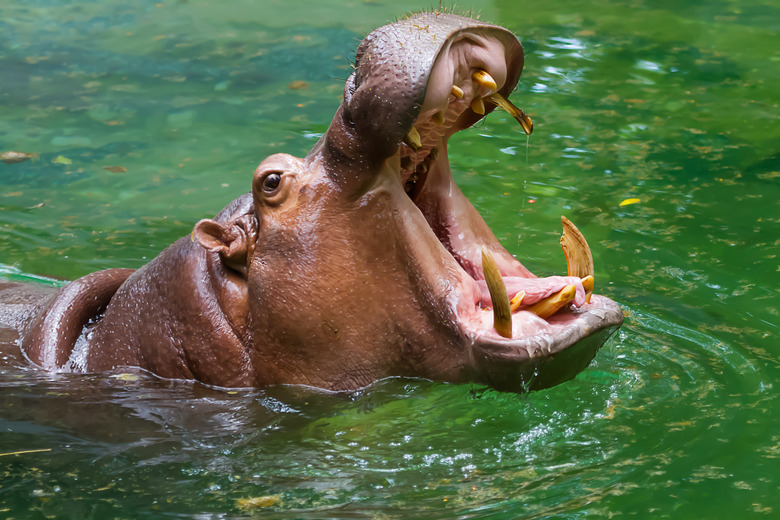The hippopotamus is a herbivorous mammal that inhabits African rivers and streams south of the Sahara Desert. Third in size among land animals only to the elephant and the white rhinoceros, the male hippopotamus can weigh more than 9,000 pounds. Most closely related to whales, hippopotamuses are highly territorial and rank among the most aggressive mammals in the world.
Sense Organs
Hippopotamuses, which spend much of their time in water, possess adaptations that make this habit possible, such as eyes, ears and nostrils positioned high on their head. The location of these sense organs allows the animal to see, hear, breathe and smell above the water while keeping the rest of its bulky body submerged. The nostrils close when the hippopotamus dips its head below the water. Hippopotamuses can also see underwater thanks to a clear membrane that protects their eyes. Moreover, it is believed that the hippopotamus’s lower jawbone allows it to distinguish sounds underwater,as in whales and dolphins.
Sweat
To compensate for its lack of sweat glands, the pores of the hippopotamus ooze a thick, red substance that is easily mistaken for blood. This discharge protects the animal from sunburn and helps keep its skin moist. Biologists believe that this secretion may have antiseptic properties that prevent the hippopotamus’s skin and open wounds from becoming infected when it comes into contact with unclean waters.
Feet
The hippopotamus belongs to the order artiodactyla, which includes hoofed animals with an even number of toes. Hippopotamuses have four toes on each foot that are separated by webbing that fans out to distribute their enormous weight. The foot construction allows them to maintain their balance while walking on land and river bottoms.
Teeth
The incisor and canine teeth of hippopotamuses — used for fighting rather than eating — grow incessantly throughout their life. The lower canines of the male hippopotamuses, who do most of the fighting, can be up to 1.5 feet long. The lower canines constantly rub against the smaller upper canines and keeps the former sharp. In females, the canines are much shorter.
Feeding Adaptations
Hippopotamuses have thick lips and wide snouts that are designed for grazing. Their largely inactive lifestyle goes hand in hand with their diet, which consists of amounts of grasses that are tiny in relation to their size and therefore do not provide much energy. A hippopotamus’s stomach can hold two days’ worth of food, according to the San Diego Zoo. If necessary, hippopotamuses can forgo eating for up to three weeks.
Tail
Hippopotamuses use their feces to define the borders of their territories. They are aided in this task by their flat tail, which the African Wildlife Foundation describes as “paddle-like.”

